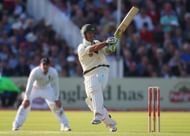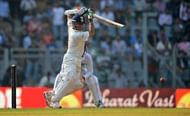No contemporary wrote more fondly about Viv Richards than Imran Khan. While mincing no words in appreciation of his genius, Imran, much in line with his own philosophy, also remarked that Richards should have retired in 1987, the year he felt the West Indian was still in his pomp.
It’s very difficult for cricketers (and sportspersons in general) to identify the tipping point in their careers. That is perhaps the reason why most players call time on their careers in the midst of a downslide; they’re unable to foresee the trough which inevitably follows a high.
In this article, we look at five batsmen who prolonged their careers in the expectation of a reversal in form that was never to be:
#1 Adam Gilchrist
Widely regarded as a once in a generation cricketer, Gilchrist could have made it to the then dominant Australian team purely as a batsman, which is saying something given the wealth of talent they had back then. But such was Gilchrist’s dominance in his domain that he never missed a Test match in his career (effectively putting the lid over prospective keeper-batsmen/batsmen-keepers who ever wished to be given a baggy green).
With respect to wicket-keeper stats, Gilchrist scored almost 2300 runs more than the next placed Mark Boucher, and his century tally (17) is also more than twice the number scored by Sangakkara and Flower (7 each; although in fewer Tests).
Splitting his career in two (not equal) parts shows that Gilchrist was at the peak of his powers until the pre-2005 Ashes period. Till then, he had almost 4500 runs in 68 Tests at an insanely high average of 55.65.
But the 2005 Ashes had many casualties and Gilchrist was one of them; from the Ashes until the end of his career, the southpaw only scored two more centuries in 28 Tests and averaged only 30.21. However, he had his moments even in this stretch, scoring the second fastest Test century, against the hapless England in Perth, but that was it. It was, perhaps, the expectation of a Gilly miracle that kept him going in the Test side for a few matches too many.
| Span | Matches | Inns | n.o. | Runs | Ave | H.S. | 100s | 50s |
| 4 Nov’99 – 20 Jul’05 | 68 | 97 | 17 | 4452 | 55.65 | 204* | 15 | 20 |
| 21 Jul’05 – 24 Jan’08 | 28 | 40 | 3 | 1118 | 30.22 | 144 | 2 | 6 |
| Career | 96 | 137 | 20 | 5570 | 47.60 | 204* | 17 | 26 |
#2 Ricky Ponting
Perhaps the only batsman to have challenged Tendulkar’s aggregates, Ricky Ponting’s career numbers are perhaps next only to Don Bradman and Greg Chappell’s in the history of Australian cricket.
An erratic individual in his early days, Ponting, in 2001, scripted a dramatic turnaround in his career through relentless discipline and a drive to perform. A sensational five year period (till Ashes 2006/07) saw him score more than 6000 runs at an average of more than 70.
His form dipped thereafter, however, he still scored relatively consistently until March 2010; but that is the time his form nosedived. That along with his controversial stand off with Michael Clarke meant that Ponting didn't stage a comeback and had to finally call time on his 17-year career in Nov 2012.
From March 2010 onwards, Ponting only scored two hundreds in 26 Tests at an average of just 33.75; this brought his career average down from 55.68 to 51.85.
| Span | Matches | Inns | n.o. | Runs | Ave | H.S. | 100s | 50s |
| 8 Dec’95 – 18 Mar’10 | 142 | 240 | 27 | 11859 | 257 | 55.68 | 39 | 51 |
| 19 Mar’10 – 30 Nov’12 | 26 | 47 | 2 | 1519 | 221 | 33.75 | 2 | 11 |
| Career | 168 | 287 | 29 | 13378 | 257 | 51.85 | 41 | 62 |
#3 Sachin Tendulkar
Many were of the opinion (and still are) that Tendulkar should have called time on his career after the 2011 World Cup. But it’s easy to say that when you are not the one who is sitting on 99 international centuries, just one milestone away from setting an impossible benchmark for the coming generations to emulate.
Tendulkar had a fantastic 2011 World Cup (482 runs; next only to Dilshan’s 500), and only a couple of months before that, scored his 50th (and 51st) Test hundreds in South Africa. The subsequent dip in form in both Tests and ODIs was unexpected, although inevitable.
In the 23 Tests that he played during this period, beginning with the tour of England until the end of his career, Tendulkar did not score a single century in 39 innings. He had the lowest average amongst all specialist batsmen (bar Sehwag & Gambhir), and the emergence of youngsters made his presence all the more unwanted.
| Span | Matches | Inns | n.o. | Runs | H.S. | Ave | 100s | 50s |
| 15 Nov’89 – 20 Jul’11 | 177 | 290 | 32 | 14692 | 248* | 56.95 | 51 | 58 |
| 21 Jul’11 – 14 Nov’13 | 23 | 39 | 1 | 1229 | 94 | 32.34 | 0 | 9 |
| Career | 200 | 329 | 33 | 15921 | 248* | 53.78 | 51 | 68 |
#4 Viv Richards
To many (myself included), he is the greatest batsmen to have ever played the game. Viv’s legend was built upon his ability to intimidate and destroy quality fast bowling. His exploits are so endearing that they demand an analysis/appreciation of their own.
For a man who inspired an entire generation of cricketers, Viv also saw his powers waning when his eyesight and reflexes began to give away. This was evident from Dec 1988 onwards. Richards played 20 Tests until the end of his career, averaging a decent but un-Richards-like 36.3, with just 1 hundred, vs India.
His genius is evident from the fact that he still managed to cross 50 in 12 of the 32 innings he played (38%), but to many, he was just not the Viv that had stridden the cricketing universe like a king.
| Span | Matches | Inns | n.o. | Runs | H.S. | Ave | 100s | 50s |
| 22 Nov’74 – 23 Dec’88 | 101 | 150 | 9 | 7487 | 291 | 53.10 | 23 | 34 |
| 24 Dec;88 – 08 Aug’91 | 20 | 32 | 3 | 1053 | 110 | 36.31 | 1 | 11 |
| Career | 121 | 182 | 12 | 8540 | 291 | 50.23 | 24 | 45 |
#5 Virender Sehwag
Virender Sehwag turned the stereotype of the watchful opening batsman on its head. There have been few more exhilarating boundary hitters in the game than Sehwag. He has scored the second highest proportion of Test runs in boundaries (63.80%) after Chris Gayle (66.15%).
A batsman possessing unbelievable hand-eye coordination, Sehwag made the most of it to plunder boundaries and bend the bowlers to his will. But much like Richards, when such instinctive abilities start to fade away, a downfall is imminent.
Amidst the fiasco of his much-publicized rift with Dhoni, it was Sehwag’s form that suffered the most. Starting from Dec’10 until his ill-fated final series, vs Australia (2013), Sehwag only scored 1 century in his the 20 Tests he played, averaging a paltry 28.77.
| Span | Matches | Inns | n.o. | Runs | H.S. | Ave | 100s | 50s |
| 3 Nov’01 – 20 Nov’10 | 84 | 144 | 6 | 7550 | 319 | 54.71 | 22 | 26 |
| 16 Dec’10 – 02 Mar’13 | 20 | 36 | 0 | 1036 | 117 | 28.77 | 1 | 6 |
| Career | 104 | 180 | 6 | 8586 | 319 | 49.34 | 23 | 32 |
Brand-new app in a brand-new avatar! Download Cric Rocket for fast cricket scores, rocket flicks, super notifications and much more!


